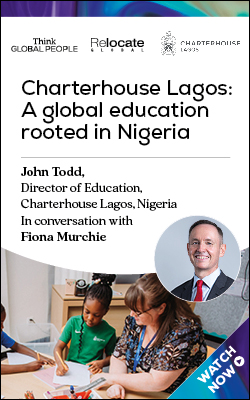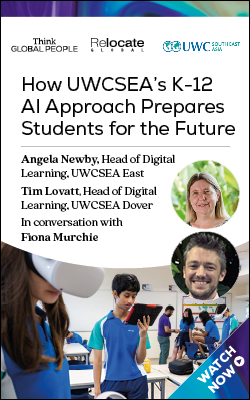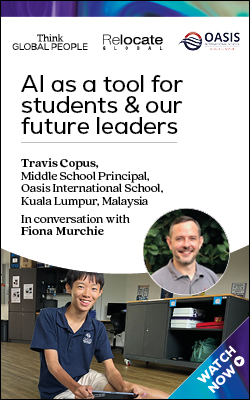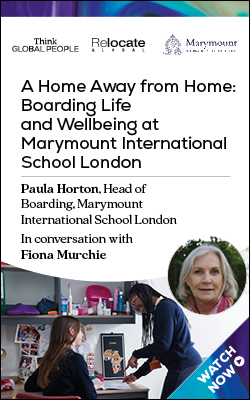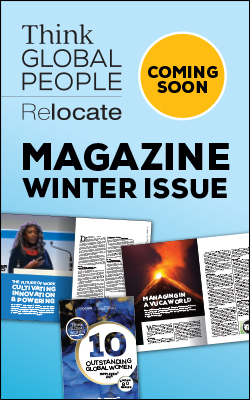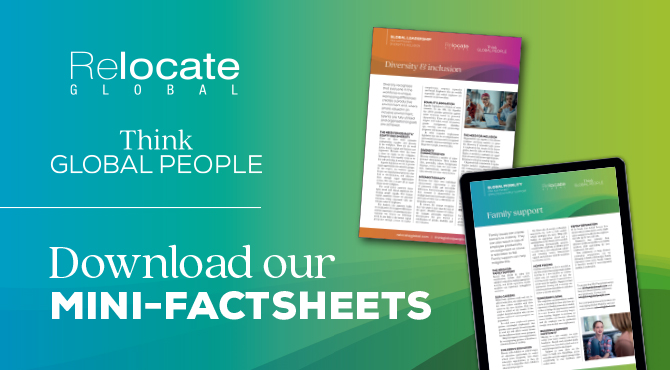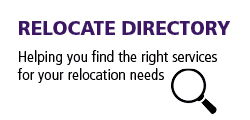The shape of mobility to come: strategy, technology, and leadership in a disrupted world
The global mobility function is being redefined and expanded amidst geopolitical upheaval, shifting demographics, AI disruption, and cultural transformation. The question facing organisations today is not whether global mobility still matters, but how it can evolve into a strategic function that shapes the future of work and helps to drive growth, profitability, employee recruitment and retention, and wellbeing at work.


Few people are better placed to unpack this transformation than Josh Winfield, Senior Manager, Global Mobility Consulting at KPMG UK. He helps organisations build resilience, relevance, and reach in a world which has many challenges in the form of economic and political volatility, and the advent of powerful Artificial Intelligences models which will transform the way we work.So how can global mobility leaders balance short-term responsiveness to geopolitical shocks with the need for long-term workforce planning in regions where political risk is high, but talent potential is even higher?“My experience is that clients get drawn into the operational day to day delivery of their roles, and instead they need to give themselves the opportunity, or find the time to step back and think about these wider demands and these wider trends,” Josh explains. “Look at what data is available and use that to assess the opportunities and the threats within the regions and employee groups they are responsible for. That will help them and their teams to become more strategic.”He says talent leaders need that space and time to do future planning and assess the overall geopolitical situation, although he acknowledges that this can be difficult when departments are under pressure.“It is a mindset shift, to go beyond a reactionary approach, and think, what are the repercussions of this change? What does that mean for my role? How does my team need to evolve to deal with these new demands?”
Three pillars for success in a world in flux
In thinking through the future of global mobility, Josh says three key themes emerge:- Global awareness in a fragmented world
Leaders must have a firm grasp of the geopolitical, regulatory, and economic realities in the markets they operate in. This includes everything from immigration reform in the US and UK to policy changes across Europe, and the evolving regulations in regions like Africa, the Caribbean, and South America. Companies must understand not just where they can operate, but where it makes sense to move talent—particularly in a world where the cost and ROI of mobility are under greater scrutiny. - Supply chain agility and risk management
Geopolitical change now creates ripple effects through supply chains—including the people side. Moving talent quickly and legally, navigating new borders (literal and virtual), and ensuring cross-functional coordination requires a new level of preparedness. Where once mobility teams focused on long-term, static assignments, they now manage a range of mobile arrangements: short-term projects, remote deployments, frequent travel, and hybrid placements, as well as regular employee requests for remote and hybrid working arrangements which may have tax and legal implications for the company as a whole, as well as for the individual worker. - Human-centric leadership for distributed teams
As global mobility becomes more complex, leadership must become more human and present. Leaders must balance constant change with emotional intelligence—ensuring their teams are resilient, connected, and aligned to purpose. Supporting well-being, embedding inclusion, and making space for generational and cultural nuance are central to business continuity and a positive employee experience, which impacts the ability to recruit and retain new and existing talent.
The evolution of the global mobility function
Where once global mobility teams were operational units processing visas and managing global tax and payroll compliance, they are now increasingly being expected to deliver strategic value. At KPMG, consultants are advising organisations on how to make mobility integral to business and talent strategy. That includes helping leaders choose technology platforms, define policy frameworks, and engage with the business as strategic partners and not just as administrators.Senior global mobility professionals are also increasingly being absorbed into broader HR leadership roles, including reward, benefits, pensions and people strategy. This reflects the growing need for cross-functional thinking and the potential for mobility teams to play an essential business role in strategy and long-term growth.“There is a rise in non-standard moves, and mobility is often expected to deal with them all” Josh explains. “An assignment could be wrapped up with a multitude of business travel to different locations, each of which has the potential to trigger certain compliance requirements in different countries which need to be managed or assessed to understand the significance. Added to this, there is a huge variety of cross border remote working arrangements, which could be long or short term in nature, and depending on the country, could generate a number of risks.”He says part of the shift in mindset is to transition away from long term assignments to more agile short term moves and a mixture of these hybrid roles, or roles which encompass multiple different countries at once. Often these requests are from the employees themselves.“There are a number of different barriers around remote working requests, which includes having an entity in a country, which might trigger a permanent establishment risk, or legal challenges,” he says.Immigration is often the biggest concern, because people may not necessarily have the right to work in certain countries, for example, in Europe if they are a UK national.“We don't have the implicit right to work in a number of EU locations. Therefore, employers have an option, either they allow their employees to get a remote working visa, which might also have requirements which they're not aware of, or risk the employee being identified as working illegally in that country. So depending on the risk appetite, that really will define whether or not these remote working arrangements are able to go ahead or not. That is an incredibly difficult message to tell employees, particularly when there are compassionate reasons behind the request”He says the final decision is often based on how much an organisation is willing to invest in order to make that that arrangement work for that individual, what is the value which that person brings to the organisation, and what structures the company has in place to support these requests.Read related articles
- Staying ahead: Future-proofing the global mobility function
- Getting global mobility partnerships right
- How the financial services industry is responding to global change
- Charting the road to 2030: what does the future hold for global mobility?
Watch video highlights of Global Leaders Forum
Diversity, equity, and inclusion – how to balance company objectives with government demands
How can global mobility programmes help incorporate DEI objectives, and what mechanisms can ensure that international opportunities are equitably distributed across underrepresented employee groups?In a cost-sensitive and compliance-heavy environment, initiatives around DEI (diversity, equity, inclusion) and employee well-being risk falling down the corporate agenda. But according to Josh, these are precisely the issues that organisations need to overcome whilst addressing talent pipelines.Global mobility teams are well placed to report on representation in their programmes, highlighting trends , and promoting the equitable consideration for employees to undertake global roles. However, the decision-making around who gets international opportunities often still lies with line managers and talent teams. Therefore, global mobility’s role is to inform and influence, feeding diversity data into the broader HR machine and advocating for fairer assignment processes.“Global mobility should reflect the culture and demographics of the company,” he says. “It must be equipped to support new types of assignments which may be shorter or to new or difficult locations.”Josh says that often global mobility professions will not be responsible for helping choose candidates, although they may help to inform best practice.“They will be there to provide training to the other HR functions and recruitment functions around thinking about the DEI aspects when deciding who to send on assignment. But fundamentally, in the majority of cases, mobility aren't part of the active decision making. So mobility is either reporting the demographics and looking at where individuals are being sent to, and highlight gaps to the decision makers.”He says it is the growing role of global mobility to look at how they can make policies and programmes more inclusive. Rather than looking at long term assignments which might not be appealing to some individuals within the organisation, would short of term arrangements or remote working arrangements be better?“Are there roles that are more attractive to certain demographics, which we're trying to encourage to take up global roles? Alongside the business pressure to move away from costly long term assignments, you have also got the employee pressure from individuals who might actually not want to commit to going anywhere for three to five years, especially given all the geopolitical challenges at present,” he says. “For locations which are going through geopolitical shifts people might feel more comfortable going there for 12 months to get the experience and bring it back, rather than committing to five years there.”Generational divides and the truth about remote work
So how can leaders foster a sense of belonging and cohesion in globally dispersed teams—particularly when cultural nuance, language barriers, and differing expectations about leadership are in play? In an era of generationally diverse expectations about work, what responsibility do organisations have to design hybrid or mobility programmes that accommodate varied life stages, work preferences, and social needs—without reinforcing stereotypes?A topic frequently misunderstood across leadership teams is the generational divide. There is a perception that Gen Z and millennial employees prefer remote work and want to operate entirely online. But data from client engagements suggests the opposite: younger employees are actively craving the experience of working in an office, being mentored and learning from more experienced members of staff, and being exposed to opportunities including international assignments.Meanwhile, many senior leaders who built their careers in office environments are now more comfortable working remotely, especially those with families or caregiving responsibilities. As a result there is a generational inversion of work preferences, and a growing need for leaders to balance the return to the office with the demands of more senior staff.Josh says the solution is to ensure that people feel listened to and that they can share their different experiences and different expectations.“It is about creating a sense of commonality and as you work together,” he says. “Aim to break down barriers and make workplace relationships about the people, not just the project.”Mobility moves to shorter and more focussed assignments
What are the long-term implications for talent development when traditional expatriate assignments are replaced by shorter, more transactional deployments—and how can organisations preserve institutional knowledge and leadership pipelines?The Middle East, Africa, and South America remain important emerging markets, but companies are now less likely to commit to multi-year assignments in favour of short-term, agile moves.“Companies are realising they simply don’t know where the world will be in five years,” says Josh. “It is hard to get global sign-off for a long-term move when the future is so uncertain, and senior leaders recognise that their strategy may change.”Instead, organisations are favouring more flexible deployments which might include commuter roles, short-term transfers, or hybrid contracts that allow people to join global teams without permanently relocating. This reflects a growing tension in some organisations where the value of global experience remains high, but the appetite for long-term investment is more cautious.“It is about where value is being generated for the organisation,” Josh explains. “Long term assignments are often more strategic. People are going into a country to deliver value in that three to five year role. They are bringing experience from the role in one region and applying it to another, growing that part of the business, and generating value there. Whereas in a short term role, for example six months, that is really a learning experience for you, rather than something which is going to deliver loads of value to the business. It is difficult for you to make a really tangible impact in that short amount of time, but you will get a lot out of it. You'll learn a lot about the country and the local market, which you, can then bring back to your home country when you finish that assignment.”One issue which can be a problem for talent retention is that people grow out of the role that they are supposed to be returning to, and so they leave. So what can mobility professionals do to ensure that that does not happen and that there is an interesting and challenging role for assignees when they return?“It is important to have a real focus on the repatriation activities and making sure that you are not just returning to the same role, or if you are, you have a really clear picture in your head around what is your career progression, what is your career journey?” Josh says.“That conversation should start even before you take the assignment. It is about discussing, even before you leave, how this is going to benefit you in your career pathway. Then as you come to the end of that assignment, it is also important to think about, what does this experience mean to me and the business, and what have I learned? How will this benefit me in whatever role I am moving to next?”He says it is about having a robust and honest career conversation with your line manager around your career aspirations and leveraging all of the experiences you have gleaned as an outcome of that assignment to benefit yourself and the organisation you are working for.Looking forward: planning for the five-year horizon
As global mobility leaders take on more strategic and cross-functional responsibilities, what skill sets or mindsets are most critical for them to develop in order to remain relevant and impactful in the next five years?With the exponential pace of AI development reshaping work models, how can mobility leaders ensure that they remain not just reactive to change but architects of transformation—guiding their organisations through ethical, cultural, and operational shifts?AI is expected to have a profound effect on mobility, HR, and work itself.“AI is going to change the working world faster than any political force,” Josh says. “In mobility, we need to think not just about where we send people—but why, how, and for what purpose.”Josh says hubs are expanding across Pakistan, India, the UK and Europe, as well as the Middle East and in Eastern Europe including Slovakia and Slovenia where science and technology (STEM) subjects are very popular in the education system.As global mobility enters a new era shaped by generational shifts, geopolitical uncertainty, and rapid technological transformation, leaders must move beyond transactional thinking. The challenge is no longer just about where we move talent, but why, how, and to what end. Creating a cohesive global workforce will depend on listening deeply, designing flexible yet inclusive programmes, and aligning international assignments with long-term talent development. It requires investment not only in AI and automation but in empathy, agility, and purpose-led leadership. The next five years will define which organisations merely adapt—and which ones lead. The time to act is now.

Find out more about the Think Global People and Think Women community and events.

Subscribe to Relocate Extra, our monthly newsletter, to get all the latest international assignments and global mobility news.Relocate’s new Global Mobility Toolkit provides free information, practical advice and support for HR, global mobility managers and global teams operating overseas.
©2025 Re:locate magazine, published by Profile Locations, Spray Hill, Hastings Road, Lamberhurst, Kent TN3 8JB. All rights reserved. This publication (or any part thereof) may not be reproduced in any form without the prior written permission of Profile Locations. Profile Locations accepts no liability for the accuracy of the contents or any opinions expressed herein.













